Food Fundamentals: Comparing Milk Packaging and Labelling Practices
VerifiedAdded on 2020/03/16
|6
|1480
|307
Report
AI Summary
This report provides a comparative analysis of the packaging and labelling of two milk products: Pauls No-fat milk and Bannisters Down fresh milk. The report delves into the various functions of packaging, including physical and barrier protection, containment, portion control, convenience, and security. Different types of packaging, such as plastic bottles and bags, are discussed, along with the importance of primary, secondary, and tertiary packaging. Environmental considerations, such as recycling and sustainability, are also addressed. The report highlights the essential elements of product labelling, including manufacturing and expiry dates, distributor information, and origin of the product, as well as the missing elements that affect labelling requirements. The conclusion emphasizes the importance of these dairy products in a healthy diet due to their calcium and protein content. The report uses several references to support its findings.
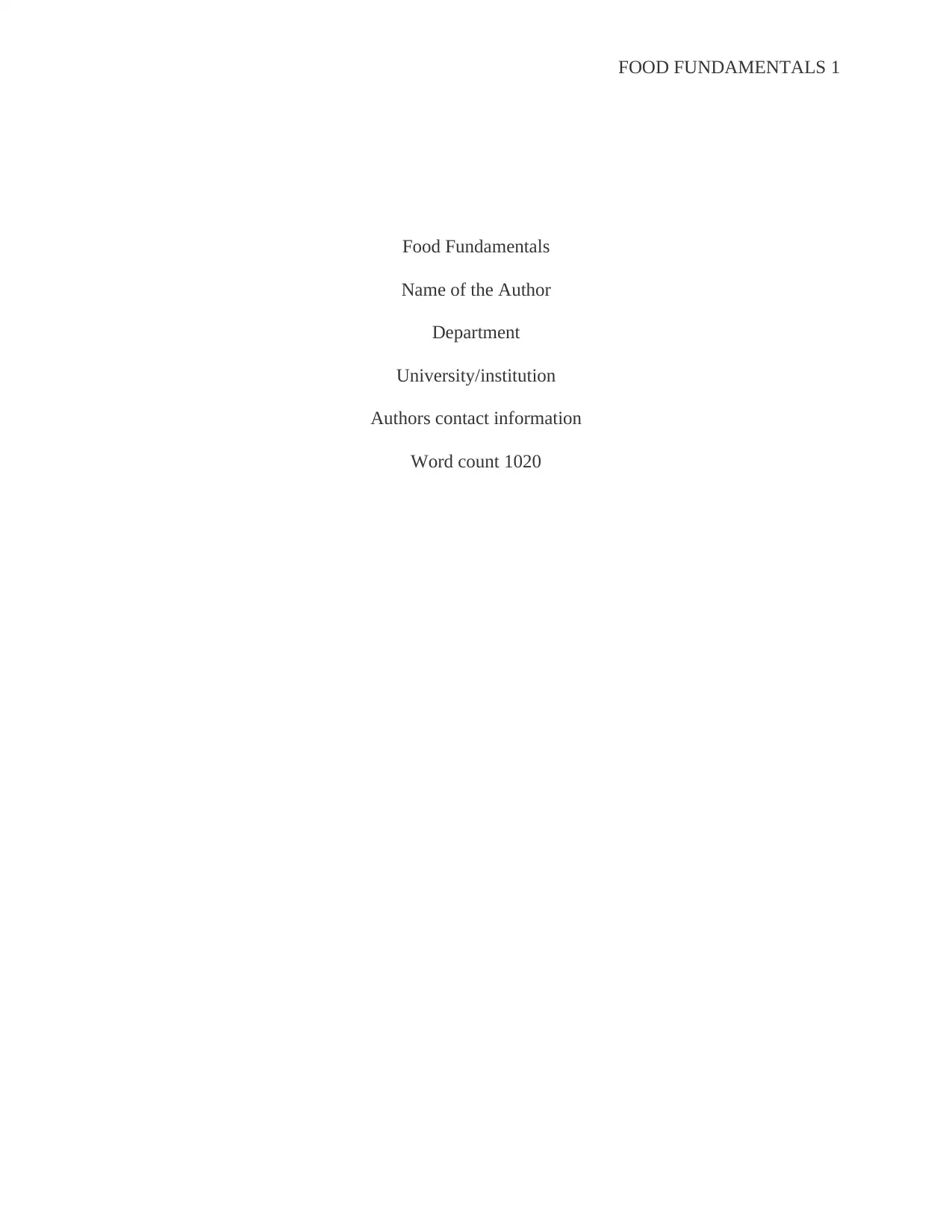
FOOD FUNDAMENTALS 1
Food Fundamentals
Name of the Author
Department
University/institution
Authors contact information
Word count 1020
Food Fundamentals
Name of the Author
Department
University/institution
Authors contact information
Word count 1020
Paraphrase This Document
Need a fresh take? Get an instant paraphrase of this document with our AI Paraphraser
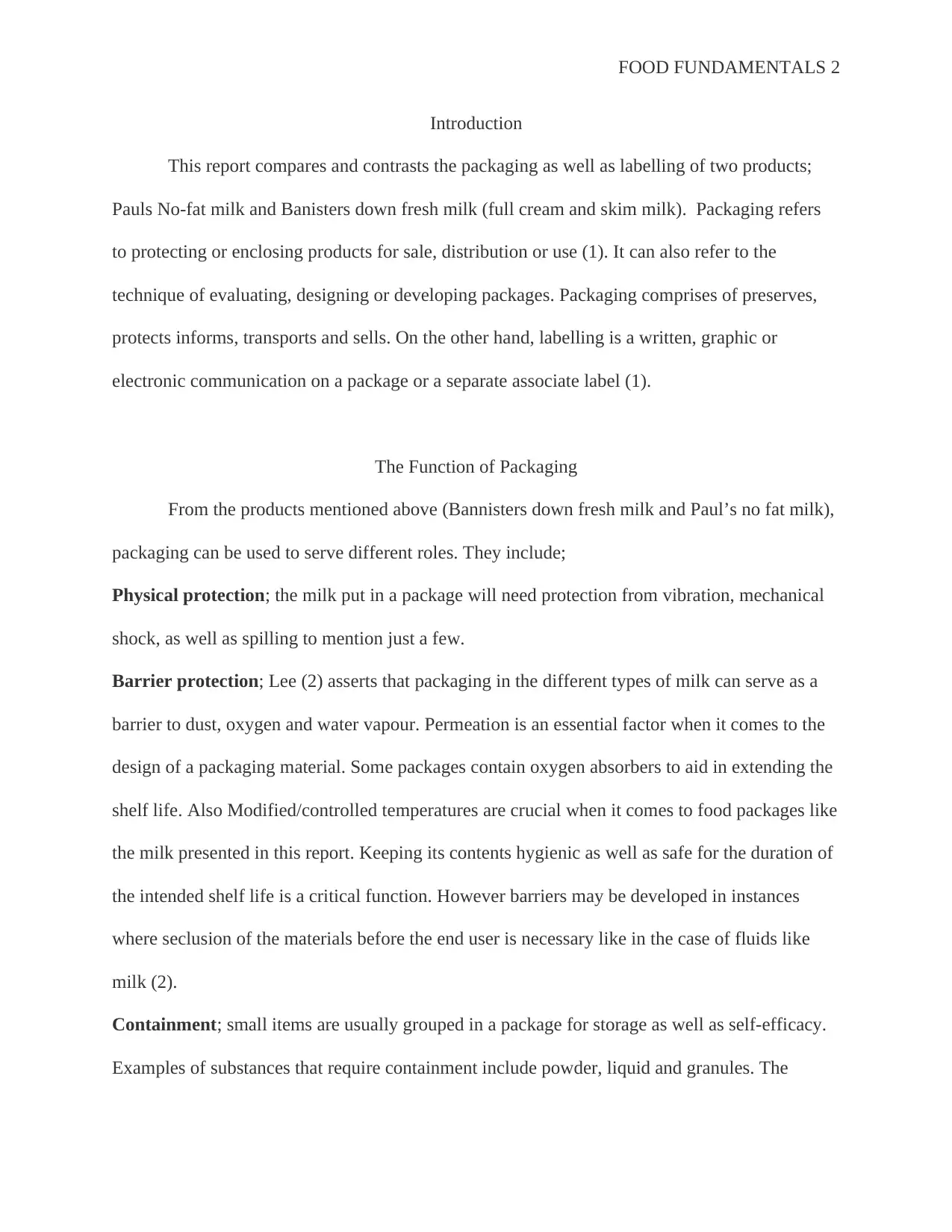
FOOD FUNDAMENTALS 2
Introduction
This report compares and contrasts the packaging as well as labelling of two products;
Pauls No-fat milk and Banisters down fresh milk (full cream and skim milk). Packaging refers
to protecting or enclosing products for sale, distribution or use (1). It can also refer to the
technique of evaluating, designing or developing packages. Packaging comprises of preserves,
protects informs, transports and sells. On the other hand, labelling is a written, graphic or
electronic communication on a package or a separate associate label (1).
The Function of Packaging
From the products mentioned above (Bannisters down fresh milk and Paul’s no fat milk),
packaging can be used to serve different roles. They include;
Physical protection; the milk put in a package will need protection from vibration, mechanical
shock, as well as spilling to mention just a few.
Barrier protection; Lee (2) asserts that packaging in the different types of milk can serve as a
barrier to dust, oxygen and water vapour. Permeation is an essential factor when it comes to the
design of a packaging material. Some packages contain oxygen absorbers to aid in extending the
shelf life. Also Modified/controlled temperatures are crucial when it comes to food packages like
the milk presented in this report. Keeping its contents hygienic as well as safe for the duration of
the intended shelf life is a critical function. However barriers may be developed in instances
where seclusion of the materials before the end user is necessary like in the case of fluids like
milk (2).
Containment; small items are usually grouped in a package for storage as well as self-efficacy.
Examples of substances that require containment include powder, liquid and granules. The
Introduction
This report compares and contrasts the packaging as well as labelling of two products;
Pauls No-fat milk and Banisters down fresh milk (full cream and skim milk). Packaging refers
to protecting or enclosing products for sale, distribution or use (1). It can also refer to the
technique of evaluating, designing or developing packages. Packaging comprises of preserves,
protects informs, transports and sells. On the other hand, labelling is a written, graphic or
electronic communication on a package or a separate associate label (1).
The Function of Packaging
From the products mentioned above (Bannisters down fresh milk and Paul’s no fat milk),
packaging can be used to serve different roles. They include;
Physical protection; the milk put in a package will need protection from vibration, mechanical
shock, as well as spilling to mention just a few.
Barrier protection; Lee (2) asserts that packaging in the different types of milk can serve as a
barrier to dust, oxygen and water vapour. Permeation is an essential factor when it comes to the
design of a packaging material. Some packages contain oxygen absorbers to aid in extending the
shelf life. Also Modified/controlled temperatures are crucial when it comes to food packages like
the milk presented in this report. Keeping its contents hygienic as well as safe for the duration of
the intended shelf life is a critical function. However barriers may be developed in instances
where seclusion of the materials before the end user is necessary like in the case of fluids like
milk (2).
Containment; small items are usually grouped in a package for storage as well as self-efficacy.
Examples of substances that require containment include powder, liquid and granules. The
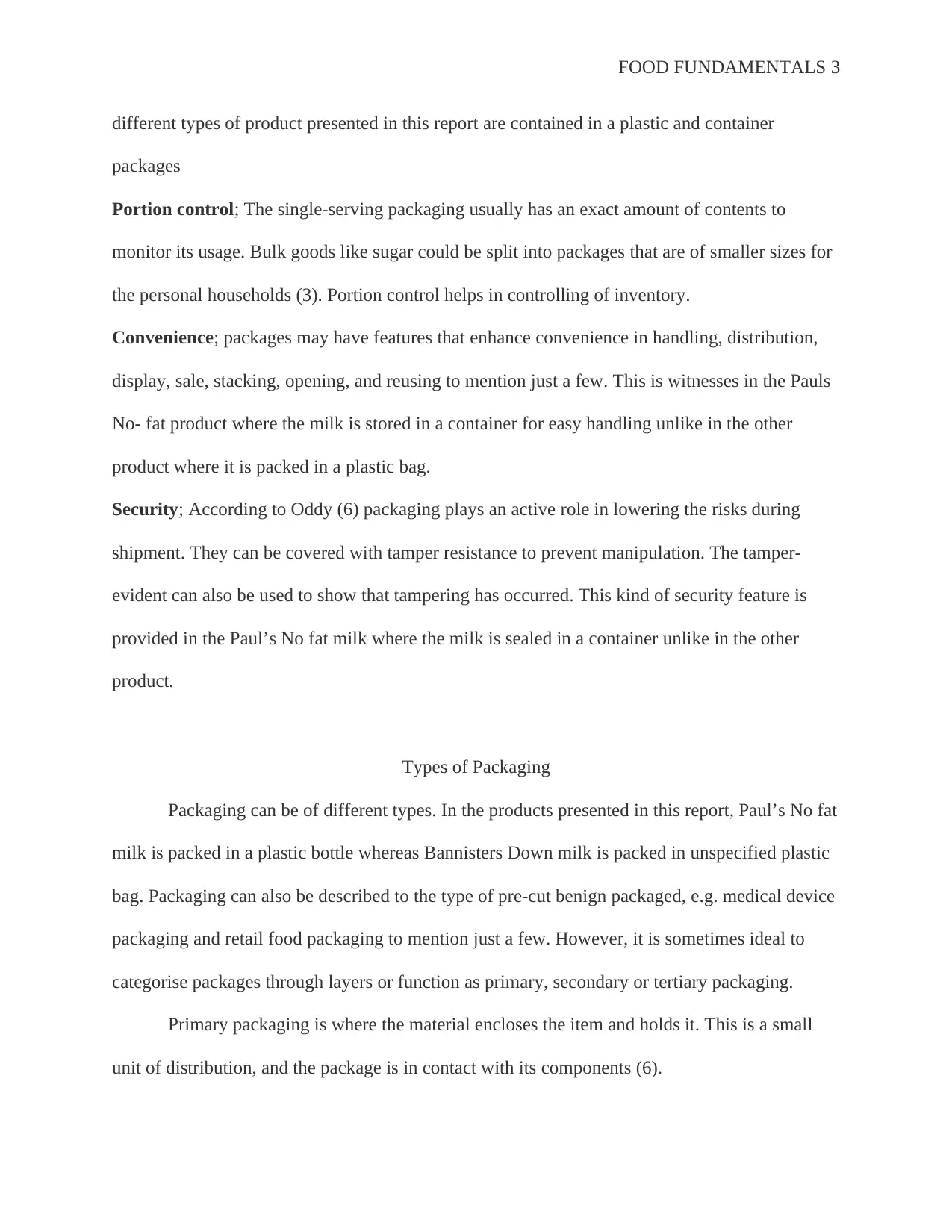
FOOD FUNDAMENTALS 3
different types of product presented in this report are contained in a plastic and container
packages
Portion control; The single-serving packaging usually has an exact amount of contents to
monitor its usage. Bulk goods like sugar could be split into packages that are of smaller sizes for
the personal households (3). Portion control helps in controlling of inventory.
Convenience; packages may have features that enhance convenience in handling, distribution,
display, sale, stacking, opening, and reusing to mention just a few. This is witnesses in the Pauls
No- fat product where the milk is stored in a container for easy handling unlike in the other
product where it is packed in a plastic bag.
Security; According to Oddy (6) packaging plays an active role in lowering the risks during
shipment. They can be covered with tamper resistance to prevent manipulation. The tamper-
evident can also be used to show that tampering has occurred. This kind of security feature is
provided in the Paul’s No fat milk where the milk is sealed in a container unlike in the other
product.
Types of Packaging
Packaging can be of different types. In the products presented in this report, Paul’s No fat
milk is packed in a plastic bottle whereas Bannisters Down milk is packed in unspecified plastic
bag. Packaging can also be described to the type of pre-cut benign packaged, e.g. medical device
packaging and retail food packaging to mention just a few. However, it is sometimes ideal to
categorise packages through layers or function as primary, secondary or tertiary packaging.
Primary packaging is where the material encloses the item and holds it. This is a small
unit of distribution, and the package is in contact with its components (6).
different types of product presented in this report are contained in a plastic and container
packages
Portion control; The single-serving packaging usually has an exact amount of contents to
monitor its usage. Bulk goods like sugar could be split into packages that are of smaller sizes for
the personal households (3). Portion control helps in controlling of inventory.
Convenience; packages may have features that enhance convenience in handling, distribution,
display, sale, stacking, opening, and reusing to mention just a few. This is witnesses in the Pauls
No- fat product where the milk is stored in a container for easy handling unlike in the other
product where it is packed in a plastic bag.
Security; According to Oddy (6) packaging plays an active role in lowering the risks during
shipment. They can be covered with tamper resistance to prevent manipulation. The tamper-
evident can also be used to show that tampering has occurred. This kind of security feature is
provided in the Paul’s No fat milk where the milk is sealed in a container unlike in the other
product.
Types of Packaging
Packaging can be of different types. In the products presented in this report, Paul’s No fat
milk is packed in a plastic bottle whereas Bannisters Down milk is packed in unspecified plastic
bag. Packaging can also be described to the type of pre-cut benign packaged, e.g. medical device
packaging and retail food packaging to mention just a few. However, it is sometimes ideal to
categorise packages through layers or function as primary, secondary or tertiary packaging.
Primary packaging is where the material encloses the item and holds it. This is a small
unit of distribution, and the package is in contact with its components (6).
⊘ This is a preview!⊘
Do you want full access?
Subscribe today to unlock all pages.

Trusted by 1+ million students worldwide
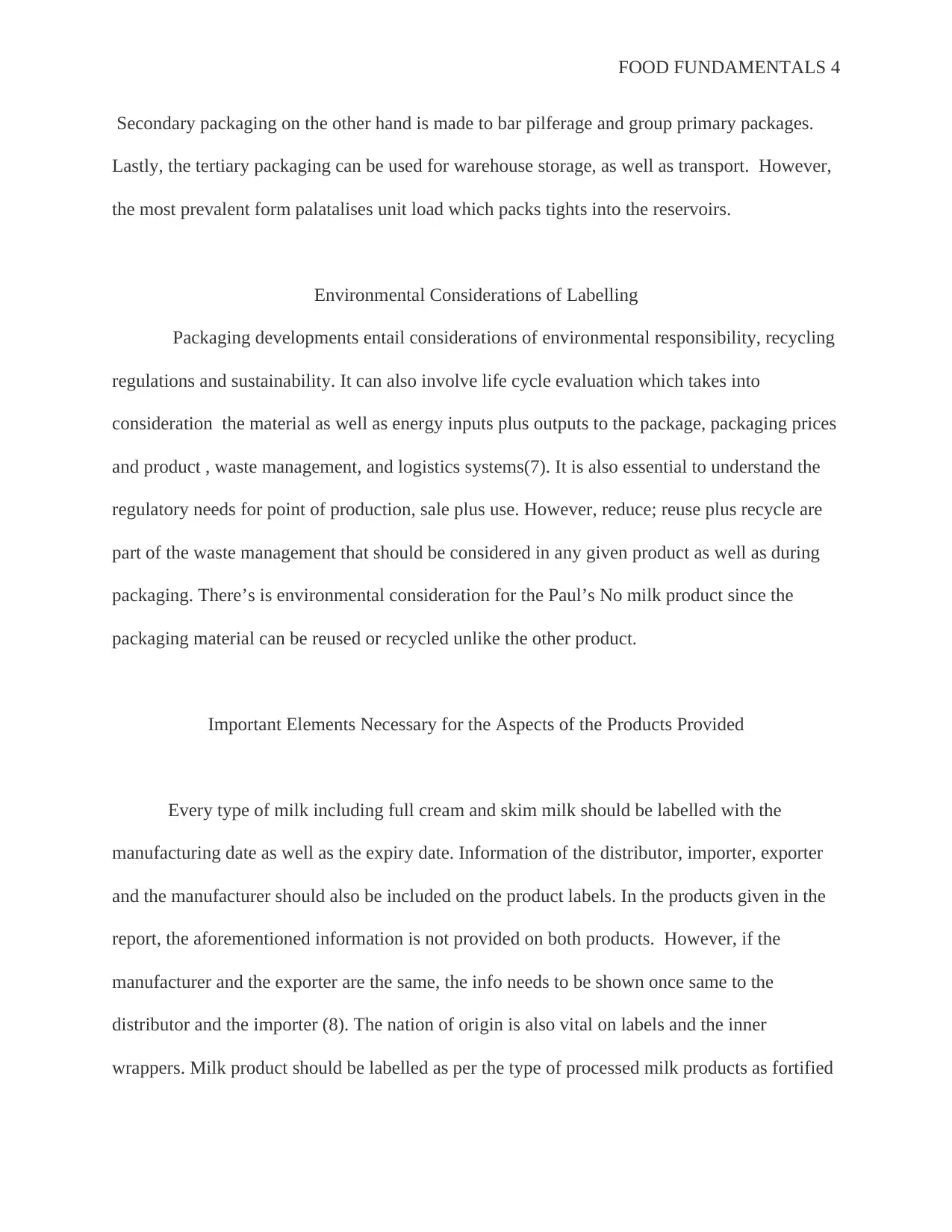
FOOD FUNDAMENTALS 4
Secondary packaging on the other hand is made to bar pilferage and group primary packages.
Lastly, the tertiary packaging can be used for warehouse storage, as well as transport. However,
the most prevalent form palatalises unit load which packs tights into the reservoirs.
Environmental Considerations of Labelling
Packaging developments entail considerations of environmental responsibility, recycling
regulations and sustainability. It can also involve life cycle evaluation which takes into
consideration the material as well as energy inputs plus outputs to the package, packaging prices
and product , waste management, and logistics systems(7). It is also essential to understand the
regulatory needs for point of production, sale plus use. However, reduce; reuse plus recycle are
part of the waste management that should be considered in any given product as well as during
packaging. There’s is environmental consideration for the Paul’s No milk product since the
packaging material can be reused or recycled unlike the other product.
Important Elements Necessary for the Aspects of the Products Provided
Every type of milk including full cream and skim milk should be labelled with the
manufacturing date as well as the expiry date. Information of the distributor, importer, exporter
and the manufacturer should also be included on the product labels. In the products given in the
report, the aforementioned information is not provided on both products. However, if the
manufacturer and the exporter are the same, the info needs to be shown once same to the
distributor and the importer (8). The nation of origin is also vital on labels and the inner
wrappers. Milk product should be labelled as per the type of processed milk products as fortified
Secondary packaging on the other hand is made to bar pilferage and group primary packages.
Lastly, the tertiary packaging can be used for warehouse storage, as well as transport. However,
the most prevalent form palatalises unit load which packs tights into the reservoirs.
Environmental Considerations of Labelling
Packaging developments entail considerations of environmental responsibility, recycling
regulations and sustainability. It can also involve life cycle evaluation which takes into
consideration the material as well as energy inputs plus outputs to the package, packaging prices
and product , waste management, and logistics systems(7). It is also essential to understand the
regulatory needs for point of production, sale plus use. However, reduce; reuse plus recycle are
part of the waste management that should be considered in any given product as well as during
packaging. There’s is environmental consideration for the Paul’s No milk product since the
packaging material can be reused or recycled unlike the other product.
Important Elements Necessary for the Aspects of the Products Provided
Every type of milk including full cream and skim milk should be labelled with the
manufacturing date as well as the expiry date. Information of the distributor, importer, exporter
and the manufacturer should also be included on the product labels. In the products given in the
report, the aforementioned information is not provided on both products. However, if the
manufacturer and the exporter are the same, the info needs to be shown once same to the
distributor and the importer (8). The nation of origin is also vital on labels and the inner
wrappers. Milk product should be labelled as per the type of processed milk products as fortified
Paraphrase This Document
Need a fresh take? Get an instant paraphrase of this document with our AI Paraphraser
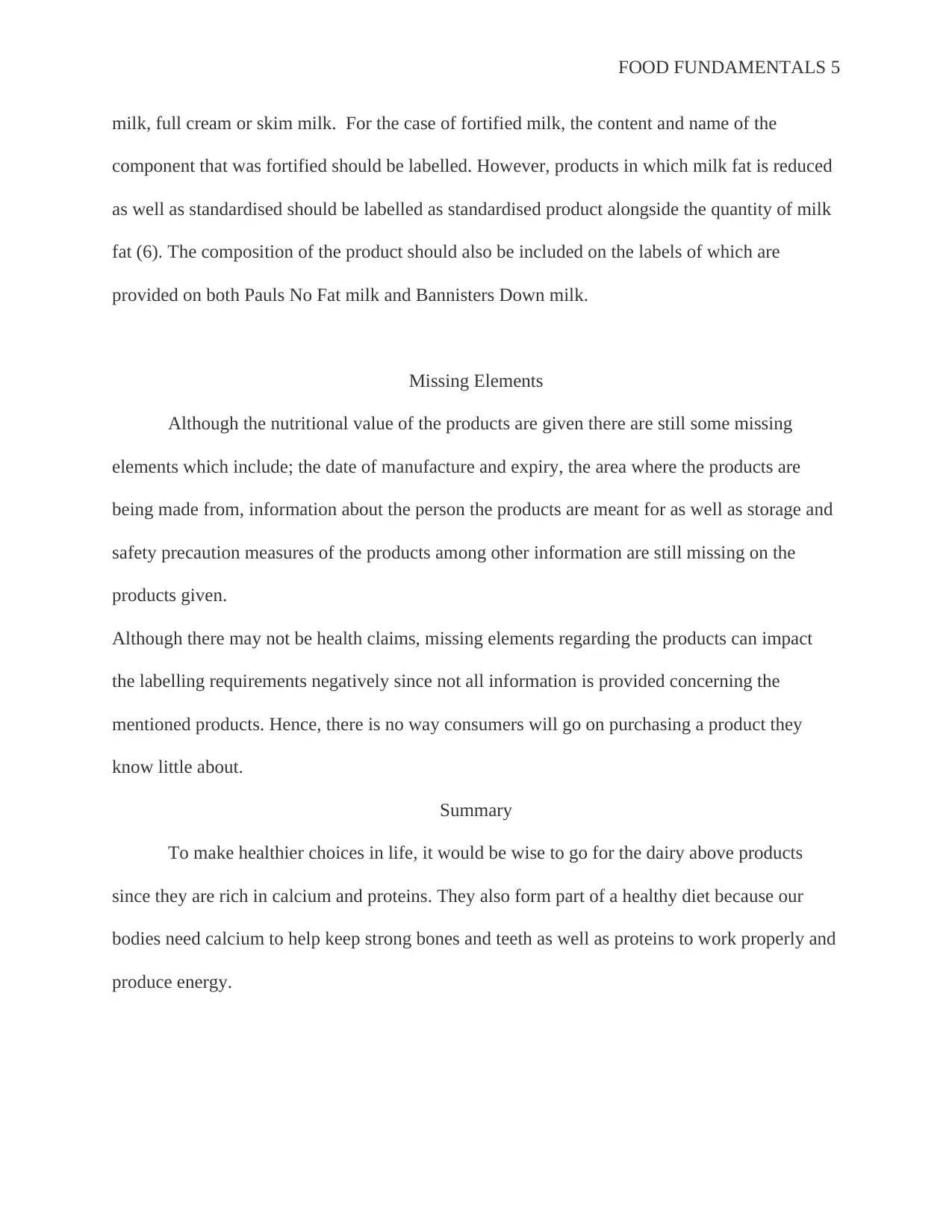
FOOD FUNDAMENTALS 5
milk, full cream or skim milk. For the case of fortified milk, the content and name of the
component that was fortified should be labelled. However, products in which milk fat is reduced
as well as standardised should be labelled as standardised product alongside the quantity of milk
fat (6). The composition of the product should also be included on the labels of which are
provided on both Pauls No Fat milk and Bannisters Down milk.
Missing Elements
Although the nutritional value of the products are given there are still some missing
elements which include; the date of manufacture and expiry, the area where the products are
being made from, information about the person the products are meant for as well as storage and
safety precaution measures of the products among other information are still missing on the
products given.
Although there may not be health claims, missing elements regarding the products can impact
the labelling requirements negatively since not all information is provided concerning the
mentioned products. Hence, there is no way consumers will go on purchasing a product they
know little about.
Summary
To make healthier choices in life, it would be wise to go for the dairy above products
since they are rich in calcium and proteins. They also form part of a healthy diet because our
bodies need calcium to help keep strong bones and teeth as well as proteins to work properly and
produce energy.
milk, full cream or skim milk. For the case of fortified milk, the content and name of the
component that was fortified should be labelled. However, products in which milk fat is reduced
as well as standardised should be labelled as standardised product alongside the quantity of milk
fat (6). The composition of the product should also be included on the labels of which are
provided on both Pauls No Fat milk and Bannisters Down milk.
Missing Elements
Although the nutritional value of the products are given there are still some missing
elements which include; the date of manufacture and expiry, the area where the products are
being made from, information about the person the products are meant for as well as storage and
safety precaution measures of the products among other information are still missing on the
products given.
Although there may not be health claims, missing elements regarding the products can impact
the labelling requirements negatively since not all information is provided concerning the
mentioned products. Hence, there is no way consumers will go on purchasing a product they
know little about.
Summary
To make healthier choices in life, it would be wise to go for the dairy above products
since they are rich in calcium and proteins. They also form part of a healthy diet because our
bodies need calcium to help keep strong bones and teeth as well as proteins to work properly and
produce energy.
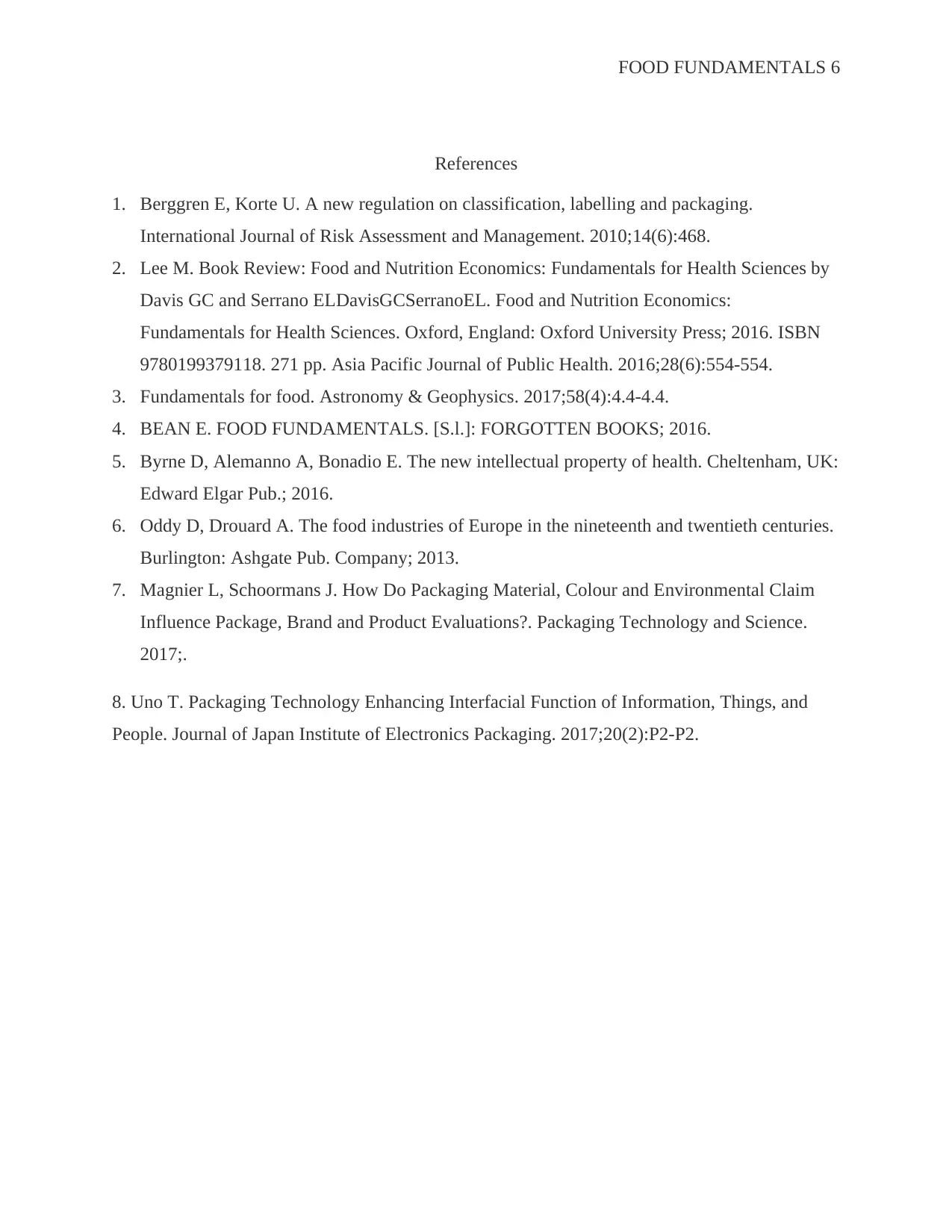
FOOD FUNDAMENTALS 6
References
1. Berggren E, Korte U. A new regulation on classification, labelling and packaging.
International Journal of Risk Assessment and Management. 2010;14(6):468.
2. Lee M. Book Review: Food and Nutrition Economics: Fundamentals for Health Sciences by
Davis GC and Serrano ELDavisGCSerranoEL. Food and Nutrition Economics:
Fundamentals for Health Sciences. Oxford, England: Oxford University Press; 2016. ISBN
9780199379118. 271 pp. Asia Pacific Journal of Public Health. 2016;28(6):554-554.
3. Fundamentals for food. Astronomy & Geophysics. 2017;58(4):4.4-4.4.
4. BEAN E. FOOD FUNDAMENTALS. [S.l.]: FORGOTTEN BOOKS; 2016.
5. Byrne D, Alemanno A, Bonadio E. The new intellectual property of health. Cheltenham, UK:
Edward Elgar Pub.; 2016.
6. Oddy D, Drouard A. The food industries of Europe in the nineteenth and twentieth centuries.
Burlington: Ashgate Pub. Company; 2013.
7. Magnier L, Schoormans J. How Do Packaging Material, Colour and Environmental Claim
Influence Package, Brand and Product Evaluations?. Packaging Technology and Science.
2017;.
8. Uno T. Packaging Technology Enhancing Interfacial Function of Information, Things, and
People. Journal of Japan Institute of Electronics Packaging. 2017;20(2):P2-P2.
References
1. Berggren E, Korte U. A new regulation on classification, labelling and packaging.
International Journal of Risk Assessment and Management. 2010;14(6):468.
2. Lee M. Book Review: Food and Nutrition Economics: Fundamentals for Health Sciences by
Davis GC and Serrano ELDavisGCSerranoEL. Food and Nutrition Economics:
Fundamentals for Health Sciences. Oxford, England: Oxford University Press; 2016. ISBN
9780199379118. 271 pp. Asia Pacific Journal of Public Health. 2016;28(6):554-554.
3. Fundamentals for food. Astronomy & Geophysics. 2017;58(4):4.4-4.4.
4. BEAN E. FOOD FUNDAMENTALS. [S.l.]: FORGOTTEN BOOKS; 2016.
5. Byrne D, Alemanno A, Bonadio E. The new intellectual property of health. Cheltenham, UK:
Edward Elgar Pub.; 2016.
6. Oddy D, Drouard A. The food industries of Europe in the nineteenth and twentieth centuries.
Burlington: Ashgate Pub. Company; 2013.
7. Magnier L, Schoormans J. How Do Packaging Material, Colour and Environmental Claim
Influence Package, Brand and Product Evaluations?. Packaging Technology and Science.
2017;.
8. Uno T. Packaging Technology Enhancing Interfacial Function of Information, Things, and
People. Journal of Japan Institute of Electronics Packaging. 2017;20(2):P2-P2.
⊘ This is a preview!⊘
Do you want full access?
Subscribe today to unlock all pages.

Trusted by 1+ million students worldwide
1 out of 6
Related Documents
Your All-in-One AI-Powered Toolkit for Academic Success.
+13062052269
info@desklib.com
Available 24*7 on WhatsApp / Email
![[object Object]](/_next/static/media/star-bottom.7253800d.svg)
Unlock your academic potential
Copyright © 2020–2025 A2Z Services. All Rights Reserved. Developed and managed by ZUCOL.


